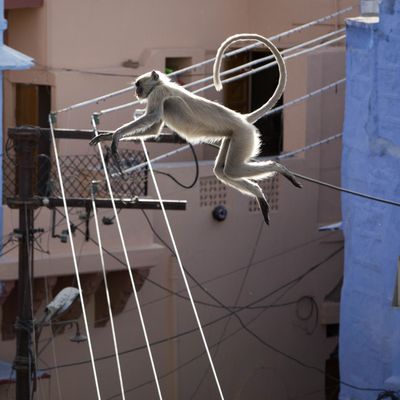
Planet Earth II knew what it was doing when it saved ÔÇ£CitiesÔÇØ for last. An unexpected and mindblowing end to the six-episode series, ÔÇ£CitiesÔÇØ takes us to a habitat ÔÇ£entirely designed and constructed by one species for its own purpose,ÔÇØ as David Attenborough puts it. Quite honestly, our cities arenÔÇÖt made for animals. But that doesnÔÇÖt mean they arenÔÇÖt living among us.
We begin with leaping monkeys. A gang of bachelor male langurs in Jodhpur, India, are here to ÔÇ£challenge the resident alpha male.ÔÇØ ItÔÇÖs like the worst bachelor party of all time. The single dudes band together to take on the alpha, as terrifying as he may be. If they win, they get the females. Sure, it doesnÔÇÖt sound politically correct, but you tell that to these guys.
(Think that looks hard for the monkeys? Imagine trying to shoot it.)
These monkeys are everywhere. Langurs are associated with a Hindu god and theyÔÇÖre revered, which means one thing: free food.
Of course, there are way less habitable cities than Jodhpur. Take Albi in the south of France, where humongous wels catfish swallow pigeons whole as they bathe. Sure, this bird is super-screwed, but as a New Yorker, it is really satisfying to watch. Good-bye, fair pidge.
Mumbai may be home to over 20 million people, but that doesnÔÇÖt mean there arenÔÇÖt terrifying predators hanging out in the shadows. Like leopards that hunt domesticated animals in the cover of darkness.
Or a spotted hyena! This is part of the squad that hangs out in the outskirts of Hamar, Ethiopia. Although it can literally chew through bones, here we see one just casually hanging out with a pal.
In Rome, millions of starlings return to the city after feeding in the countryside. They crap all over the place as they attempt to return to their roosting trees, all while creating the most gorgeous configurations in the sky.
But no one is as perfect as my new best pal, the great bowerbird, who has spent a decade ÔÇ£collectingÔÇØ (thatÔÇÖs the nice word we use for hoarders) gorgeous, brightly-colored trash for his spot on a golf course in Townsville, Australia. He moves stuff around all day to hopefully impress a visiting female.
SomethingÔÇÖs missing, though. Maybe someone next door will have something he can ÔÇ£borrow.ÔÇØ
The heart is his! But only briefly. Soon, heÔÇÖll be catfished by a young male disguised as a female. Turns out our suitor isnÔÇÖt the only bird in want of a scarlet heart. Tragic.
Next up, raccoons. I refuse to GIF them because they are totally gross. Sorry.
Back to the monkeys!!!!!!! Finally. These guys are brave as heck. The Jaipur-based rhesus macaque hop around the city like they own it. Commuting through the busy city 
 grabbing some breakfast 
 and something for later, too.
TheyÔÇÖll pay you back for that later, pal!
Tragically, not all animals handle city life as well as the macaque. Hundreds of hawksbill turtle hatchlings emerge from the sand, crawling toward the sea as fast as they can, guided by the light of the full moon. But city lights can be confusing and a bunch of them head in the wrong direction. If they arenÔÇÖt attacked by crabs waiting to snatch them, they wander straight into oncoming traffic. Nooooooooooooooooo.
(This is not the beginning of some Dunston Checks InÔÇôtype adventure. Not everyone can adapt to the city. In fact, most animals donÔÇÖt.)
With that, the question remains: Will we be waiting yet another ten years for Planet Earth III? Imagine what itÔÇÖll be like in a decade ÔÇö smaller drones, higher-quality cameras ÔÇö will we even have animals left to capture? A depressing thought, but the kind of thing the Planet Earth series leaves you pondering. If we canÔÇÖt turn around our environmentally unfriendly behavior, we certainly donÔÇÖt deserve the gifts of nature ÔÇö no matter how good they look on our 4K TVs.

